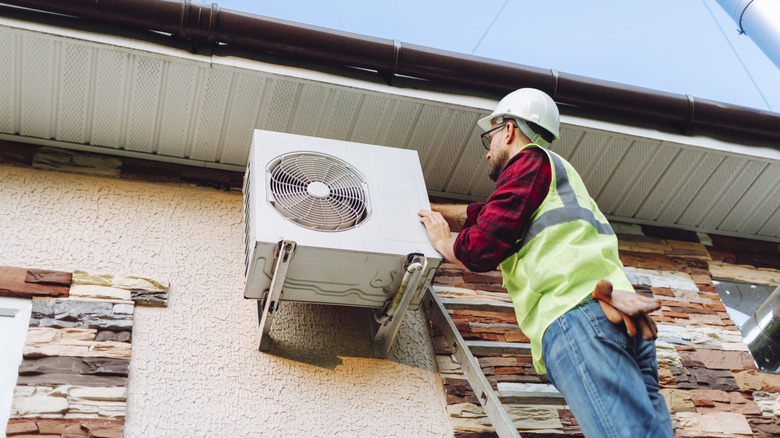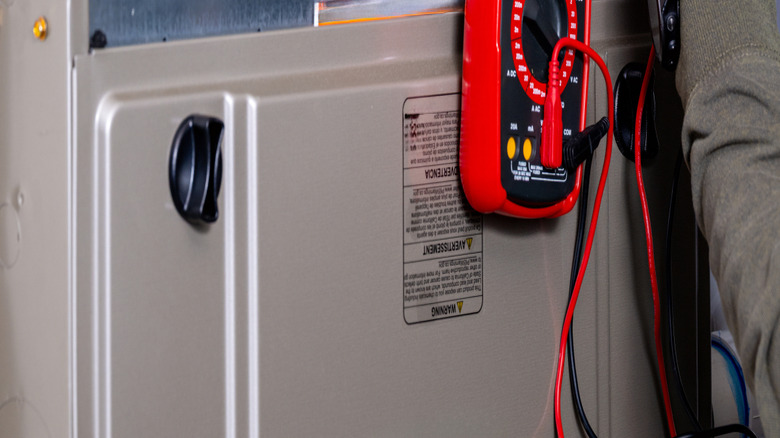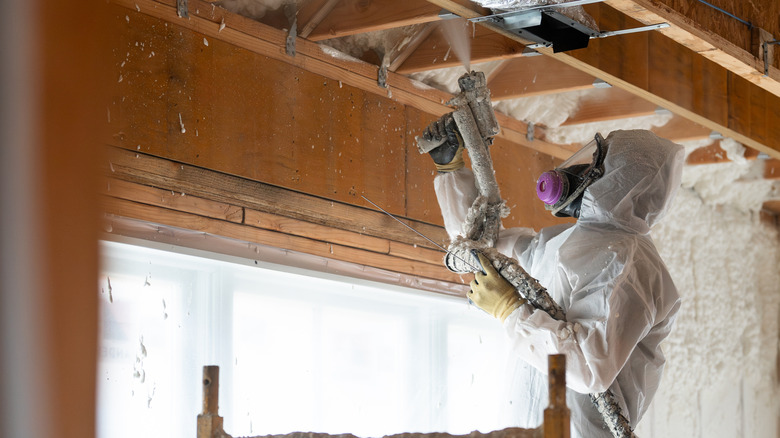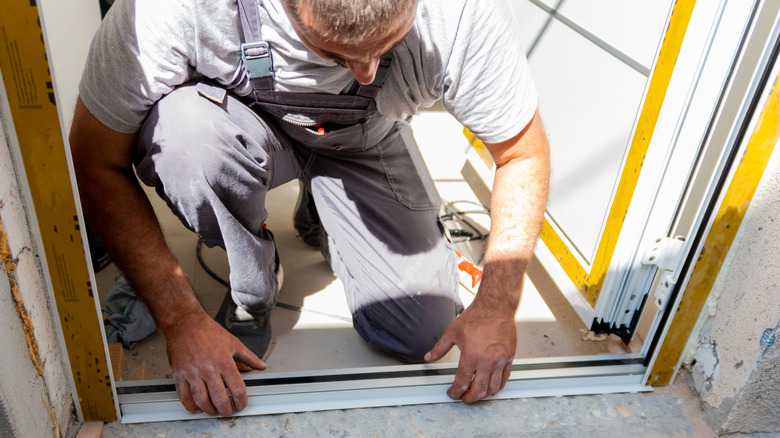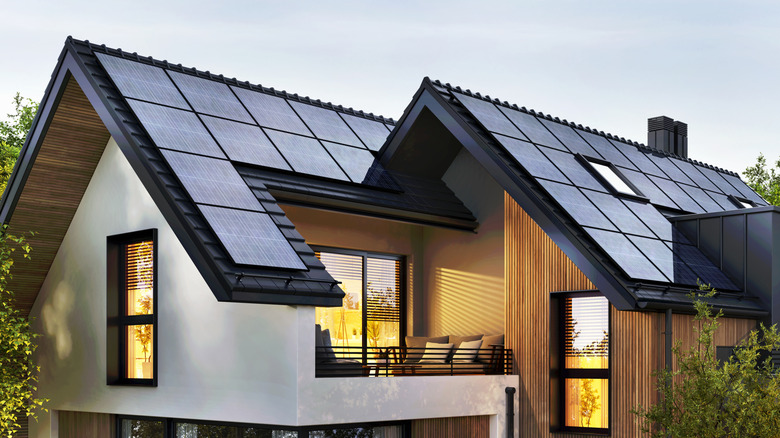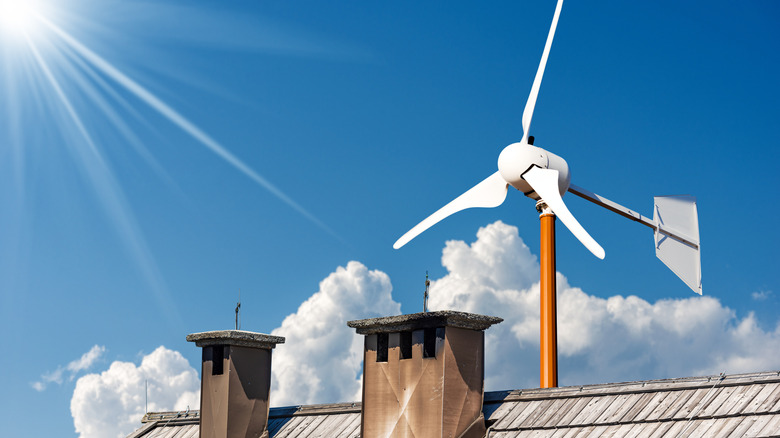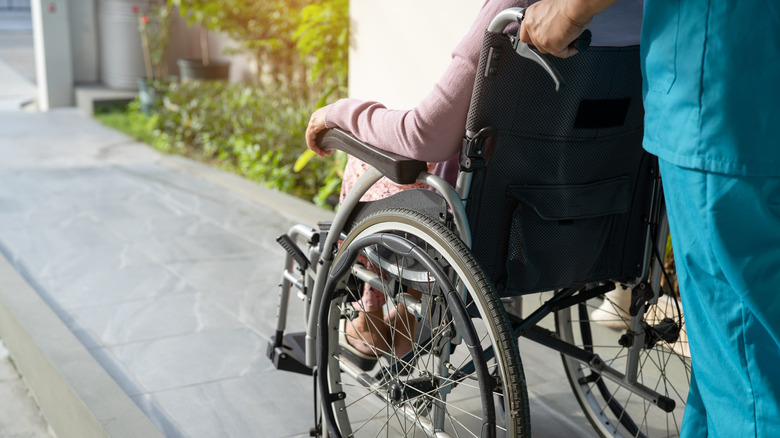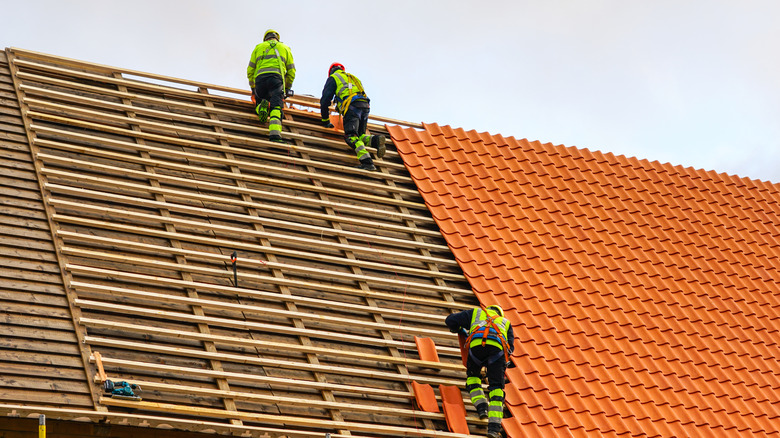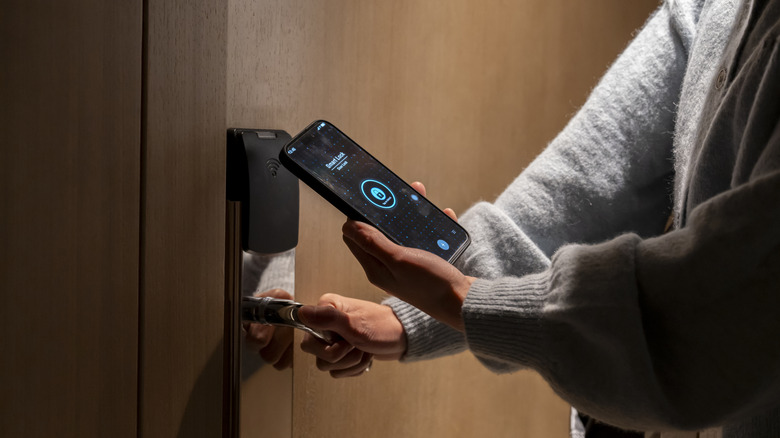12 Home Projects That Are Tax Deductible And 4 That Don't Qualify
As carbon emissions continue to grow, the federal government has allocated resources in the form of tax credits. People who install green technologies like energy-efficient casement windows and HVAC systems may be eligible. While credits often don't cover the full cost of these projects, the upgrades can keep your home warmer in the winter and cut down on your electric bills. The Trump administration's "Big Beautiful Bill" may soon eliminate many of the energy-saving tax credits that were adopted or expanded in the Inflation Reduction Act (IRA) of 2022. Two major pieces of legislation — the Energy Efficient Home Improvement Credit (which can save you up to $3,200 a year) and the Residential Clean Energy Credit — are set to expire at the end of 2025.
Tax-incentivized renovations don't end with green technology; there are also several deductions that benefit households with one or more disabled residents (the tax code recognizes that most homes are simply not designed for people with decreased mobility). Millions of Americans struggle climbing steps or supporting themselves while using the restroom, and this requires them to spend money on handrails, ramps, and even motorized lifts. These deductions are part of a federal effort to allow more Americans to live healthy lives, not just those who can afford expensive home modifications.
Most other renovations are not tax deductible because they either serve a cosmetic purpose or fall into the luxury category. There are also necessary renovations that you can't write off on your taxes — some homeowners who live in seismically active areas must retrofit the foundations of their houses, for instance. While this type of renovation is not tax deductible, it might be covered by state grants.
Installing an energy-efficient heat pump to reduce your electric bills
For millions of American households, an old heat pump is cause for anxiety. You know a big bill is on its way when the pump starts running continuously and leaving some rooms cold and others a bit too hot. It can cost anywhere between $8,000 and $15,000 to replace a pump. If you suspect your heat pump is going bad, however, you may want to have it replaced before the heat pump tax credit expires after December 31, 2025. Until the end of the year, the IRA will still allow you to write off up to $2,000 worth of the pump's cost, as long as it meets the standards of the Environmental Protection Agency (EPA).
The EPA's energy guidelines are designed to reduce carbon emissions and save you money on your electric bills each year. Before you purchase your heat pump, check Energy Star's website to make sure that the pump you want to buy qualifies for this credit. There are no income limits on this tax credit.
Replacing your furnace to a more fuel-efficient design
If you have purchased and installed a natural gas or oil furnace since January 1, 2023, you may qualify for a tax credit of up to $600. The furnace must be Energy Star certified and "meet or exceed the highest efficiency tier (not including any advanced tier) established by the Consortium for Energy Efficiency, which is in effect as of the beginning of the calendar year."
If you are in the market for a furnace, try to ensure that the product passes this standard. Not only will it qualify you for the tax credit, but it will also save you money with its top-tier fuel efficiency. For now, the average homeowners' financial interests dovetail with the federal government's environmental initiatives. However, you only have until the last calendar day of the year to take advantage of this tax credit.
Upgrading windows to lower your electric bills
According to the Department of Energy, windows are to blame for up to 30% of residential homes' heating and cooling energy use. That's because when you heat your home, you're also heating the cold glass windows. Until it expires at the end of this year, the Energy Efficient Home Improvement Credit will cover up to 30% of the cost of energy-efficient windows and skylights. The maximum amount a household can receive for this renovation is $600. The windows you plan on replacing must be part of an exterior wall to qualify for this tax credit.
Replacement windows and skylights not only lower your carbon emissions, but they also save you up to $600 a year. Energy-efficient glass often uses double- or triple-pane glass with insulating gas that locks out heat or cold air. There are also filters that keep ultraviolet (UV) light from heating your home during the summer. This tax credit does not have income limits.
Renovating your insulation to keep your home warm
Until the end of the year, the federal government will credit up to $1,200 on insulation replacement in your home. Quality insulation is one of the most important steps to keeping a house warm throughout the winter, and help reduce your energy costs at home. The EPA estimates that you can save up to 15% of your heating and cooling costs by reinsulating your home.
Products that qualify include blow-in fibers, expanding spray, rigid boards, and pour-in-place. You can also use this credit on products that block air leaks in your home, including caulk, house wrap, and weather stripping. You can reduce air infiltration by 25% if you seal leaks that release heat and air conditioning through your home's ceiling, through the floors, and through gaps around windows and doors. Just make sure the product has a Manufacturer's Certification Statement.
Replacing exterior doors to keep more heat in your house
You don't have to leave the door wide open to waste electricity during the winter. Doors are not as well insulated as your walls, so they will release heat even when they are closed. But there are energy-efficient doors that tend to trap more heat, which will save you a chunk of your electric bill. Until the end of the year, the IRA offers tax credit for energy-efficient doors that is capped at $250 per door and $500 total. You must use it on exterior doors.
The doors you decide to buy must be Energy Star-certified to qualify for this tax credit. This certification ensures that the doors you purchase are able to insulate your home properly so you don't end up getting ripped off. The Energy Star Climate Zone Finder will recommend the right door for your part of the country. Certified doors might have features like polyurethane foam cores and weatherstripping to mitigate air leaks.
Installing solar panels to lower your carbon footprint
The Energy Efficient Home Improvement Credit offers a tax break to homeowners who install solar panels as well. This 30% credit covers expenditures for solar panel additions to new or existing homes. This includes the cost of labor, equipment needed for installation, the sales tax on expenses, and of course the cost of the panels themselves. The average cost, before incentives, to fully power a house with solar panels is $21,000 to $30,000. Since panels typically last between 25 and 35 years, you should be able to recoup your money.
Make sure to keep your purchase receipts to show to the Internal Revenue Service during tax season. Like all of the previously mentioned tax credits, there are no income limits on this credit. Also, certain states offer rebates of up to $5,000 for solar panel installations, so visit your state government's website to see if you qualify.
Installing a small wind turbine to produce energy for your home
Since Jimmy Carter put solar panels on the White House, the country has been broadly aware of solar panel use for residential properties. But most people don't know that you can power a house with your own wind turbine even more efficiently than solar panels. Yes, wind turbines don't just need to be behemoth machines like those that dot the flatlands of Texas. There are plenty of much smaller wind turbines that you can buy for a few hundred bucks and attach to your roof. They are about the size of a satellite dish and often look like something attached to a spaceship in a science fiction movie.
Federal energy credits up to 30% of your purchase and installation fees. The device will likely cost you a few hundred dollars, but it will save you between a few hundred dollars and $3,500 a year. This technology should work best if you live in a flat, windy area, like the Midwest or on the ocean.
Lowering kitchen cabinets to help people who use wheelchairs
If you use a wheelchair, you know it can be impossible to reach the higher shelves of most kitchen cabinets. Especially in the morning, this can add so much inconvenience to a person's life, making what should be a calm and relaxing breakfast a frustrating, herculean task. But it's also a very time-consuming, expensive job to lower kitchen cabinets. The job requires completely redesigning the kitchen. You have to buy new countertops and hire a carpenter to remodel almost everything. But at the end of the year, you are able to write this off on your taxes thanks to the accessible home modifications tax deduction.
While preparing your taxes at the end of the year, it's helpful to understand the terminology. So far, this article has discussed tax credits, which are a reduction on what you owe to the government. Deductions, on the other hand, allow you to lower your taxes by subtracting deductible expenses from your declared income.
A ramp for your home
Stairs are an obstacle for a lot of people, and often the best solution is a ramp, especially if you need to use a wheelchair. The federal government allows you to claim the cost of a ramp as a medical tax deduction. You just need to show that either you or a dependant needed the ramp, which is something that a doctor can help with. If you want to pick up a rank from a local big box store, here's our guide to the best deals on ramps at Lowe's versus Home Depot.
This is an important tax deduction because it ensures that ramps are not restricted to people who can afford the materials and labor to build them. All disabled Americans now have access to this necessity thanks to the public sector, but they didn't always. Federal tax deductions for disabilities originated under the administration of Franklin Delano Roosevelt, who signed into law the Revenue Act of 1942, which introduced a tax deduction for "extraordinary medical expenses."
A lift for your home to help people with reduced mobility
About a million adults are hospitalized each year because of fall-related injuries. If a person falls once, it doubles their chances of falling again. After an older person falls, they could be stuck for hours before someone helps them. A bad fall can take away the freedom and security in older age that millions of people spend their entire lives working for. This is a sad and frightening part of growing older. Falls on the stairs are particularly dangerous, which is partially why the federal government offers tax deductions for lifts.
This technology allows people to sit down in a chair, push a button, and ride a rail all the way to the top or bottom of the stairs. Thanks to lifts, older folks can stay in their homes longer than they would be able to otherwise. For this benefit, the IRS requires that you show a prescription from your doctor and unreimbursed costs exceeding 7.5% of your adjusted gross income.
Installing a swimming pool for people with hydrotherapy needs
Swimming pools are almost never tax deductible because they usually fall under the luxury category. But there is an exception for every rule. For many Americans, swimming pools are not a luxury but a needed treatment for arthritis. The National Institute of Health reports that warm-water pools offer a low-impact environment for people with joint pain to exercise. If you want to deduct a warm-water pool from your taxes, you'll need a prescription from a doctor who can confirm that this treatment is necessary.
In-ground pools usually cost between $25,000 and $100,000, and a heater can run you between $1,600 and $5,200. This will definitely jack up your property taxes and homeowner's insurance, so keep that in mind. You can also purchase an above-ground pool for between $1,800 and $5,000. These prices are out of reach for millions of Americans, which is why the tax deduction is in place.
Installing handrails in bathrooms for residents prone to falling
It is estimated that 80% of household falls happen in the bathroom. Wet tubs and tile floors are slippery spots, and it's also hard for many people to lift their legs over the walls of the tub. The bathroom is often pretty dark at night, and people tend to be groggy when they are using it during the late hours. That's why if you struggle with balance, it is essential that you fit your bathroom with preventative measures. You can, of course, deduct these expenses at the end of the year as long as you keep your receipts and obtain a prescription from your doctor confirming that the home modification was necessary.
You can reduce the risk of severe falls by adding grab bars near your toilet or shower, placing non-slip mats in the tub and on your bathroom's tile floor, or even by having a shower chair installed. These features will help you find traction and support in the restroom. Also consider adding nightlights to your bathroom and the hallway leading to it.
There are no tax deductions for foundation retrofits
Tens of millions of people live in seismically active parts of the country, particularly on the West Coast, where thousands of earthquakes occur along the San Andreas fault line each year. But there is also rising seismic activity in states like Oklahoma and Texas, which has been linked to a common practice in which oil and gas companies dispose of wastewater beneath the ground. This is particularly an issue because many homes are not designed to withstand earthquakes, even in states like California and Oregon. That's why some homeowners spend anywhere from $3,000 to $7,000 to reinforce their homes' foundations. You would think you'd be able to deduct the cost of an earthquake retrofit, but you can't, since it is considered a capital improvement.
If you need to retrofit your home, you should check with your state government to see if you can fund the project, at least partially, with a grant. For instance, California has an Earthquake Brace + Bold incentive program that offers up to $3,000 to help homeowners secure the frames of their homes to their foundations. Only certain houses in specific zip codes are eligible.
There are rarely tax deductions for roof replacements
Wondering whether it's best to repair or replace your roof? Roofs last about 25 to 30 years, so there's a good chance you'll have to replace your roof at some point if you're a homeowner. An old roof can lead to extensive water damage that can affect nearly all aspects of your home. While roof repairs or replacements cost thousands of dollars, for the vast majority of people there is no tax deduction for this type of work. That's because roof replacements fall into the category of home improvements rather than necessary repairs. Other routine repairs, like porch railing replacements and driveway resurfacing, are also not tax deductible.
Roof replacements are only tax deductible in a narrow set of circumstances. If you work from a home office, you can deduct part of the roof replacement's cost. For instance, if the office takes up 15% of the home, you can deduct 15% of the roof replacement. You can also deduct the cost of a roof replacement in a rental home that you own (one of the various tax breaks you can get by owning a second property). And lastly, if a natural disaster, like a fallen tree or a hurricane, destroys your roof, you can try to claim a casualty loss deduction.
Luxury additions like home theaters are not tax deductible
You cannot deduct home theaters because these are considered luxuries, meaning they serve no medical or energy-saving purpose. Perhaps you could find a rare case in which a home theater could be categorized as a business expense, but unless you're a professional film director, that's probably not possible. Other luxuries include tennis courts, bowling alleys, and art studios (unless you make income as an artist).
The tax code is set up to encourage certain spending. For instance, the tax code is often friendly to business owners and provides various deductions. Even some workers, especially those who work from home, can benefit from deductions. The tax code also encourages homeowners to spend money on energy-efficient technologies, as previously discussed. But the tax code does not incentivize entertainment expenses, especially when you consider how some renovations can increase your property tax.
Home security systems are not tax deductible
You may feel safer with alarms and cameras around your home, but you cannot receive a deduction for installing this type of technology. That's because the IRS designates home security systems as a personal expense. But there are a few exceptions to this rule.
If you have a home office, you can deduct a portion of your home security expenses. For instance, if the office takes up 10% of your home, you can deduct 10% of what you pay for services like ADT. Your security expenses might also be deductible if you run a daycare business out of your home. Landlords will often deduct the cost of security systems for their rental properties from their taxes. Home security systems are still often worth the expense, because they add peace of mind and tend to lower insurance premiums.

